Florida is home to the only living coral barrier reef system in the continental United States, the Florida Reef Tract. It stretches along Florida’s southeast coast, from Miami to the Dry Tortugas, and covers approximately 360 linear miles of coral reefs. The Florida Reef Tract consists of various reefs, including the Upper Keys, Middle Keys, and Lower Keys reefs. These reefs are part of the larger Caribbean coral reef system.
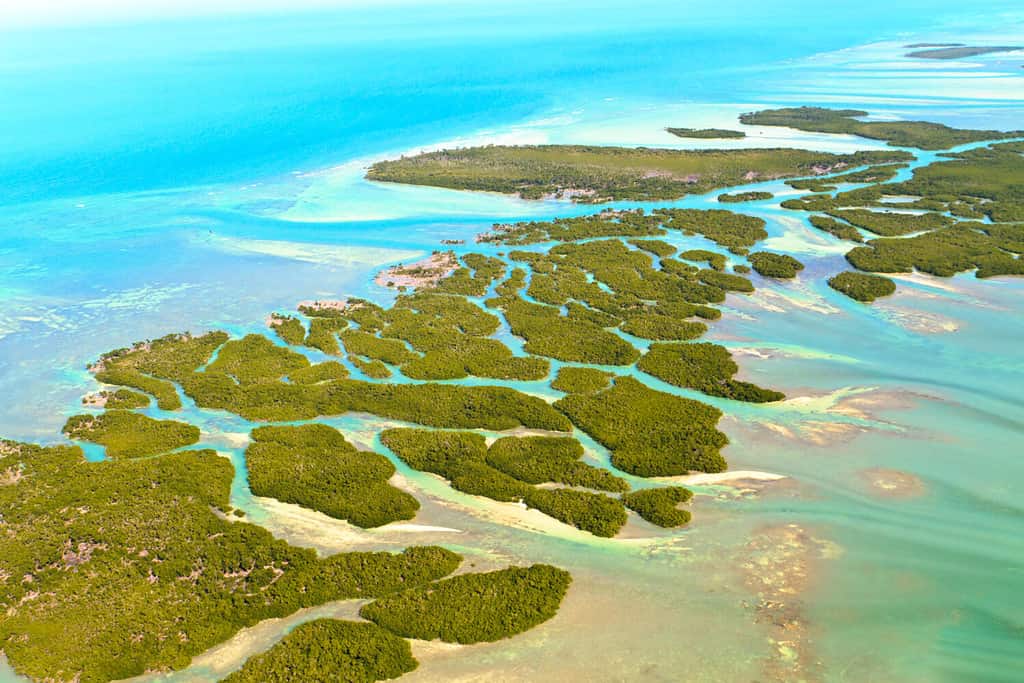
This is an aerial view of the Florida Keys, where there are many coral reefs.
©Bertl123/Shutterstock.com
It is challenging to determine the exact number of individual coral reefs within the Florida Reef Tract. It includes numerous patch reefs, spur and groove formations, and larger reef structures. The ecosystem is diverse, with a variety of coral species, sponges, fish, and other marine organisms inhabiting the different reef formations.
1. Molasses Reef
Molasses Reef is located within the Florida Keys National Marine Sanctuary, which encompasses the waters surrounding the Florida Keys. Situated off the coast of Key Largo, Molasses Reef is popular for its breathtaking underwater scenery. It is also easily accessible to divers and snorkelers. The reef system stretches for about 2 miles and features a diverse range of coral formations. Formations include elkhorn and brain corals, as well as colorful sponges and sea fans. Molasses Reef is also home to several shipwrecks, such as the Benwood and the City of Washington, adding an additional layer of intrigue for divers.
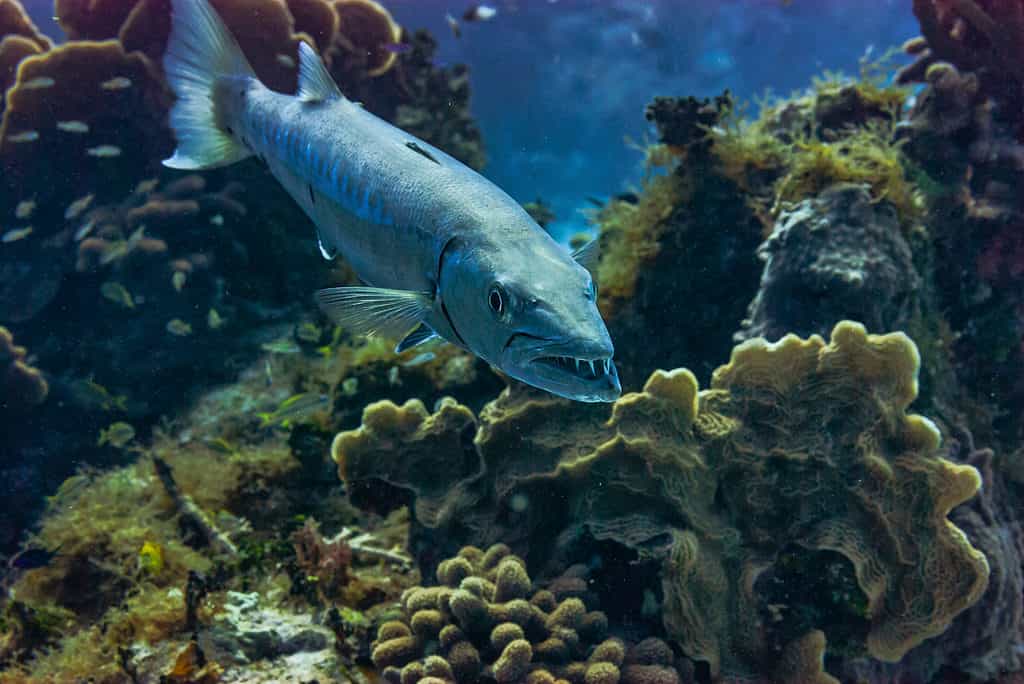
Barracudas are common inhabitants of Molasses Reef.
©Focused Adventures/Shutterstock.com
The reef’s vibrant ecosystem attracts a rich variety of marine life. Divers and snorkelers exploring Molasses Reef may encounter a wide array of species, including colorful tropical fish like parrotfish, angelfish, and butterflyfish. Larger inhabitants, like barracudas, tarpon, and nurse sharks, are also frequently spotted in the area. Molasses Reef is a haven for marine biodiversity. With its coral formations providing crucial habitat and shelter for countless organisms, it is a must-visit site for nature enthusiasts and underwater explorers in Florida.
2. Sombrero Reef
Sombrero Reef is located near Marathon in the Middle Keys of Florida. It is a popular diving and snorkeling site known for its exceptional underwater beauty. The reef derives its name from the nearby Sombrero Key. It features a distinctive lighthouse that adds to the picturesque surroundings. The reef system covers an extensive area and consists of vibrant coral formations, including staghorn and elkhorn corals, as well as an abundance of marine life. Its clear waters and diverse underwater landscapes make Sombrero Reef a captivating destination for underwater adventurers.
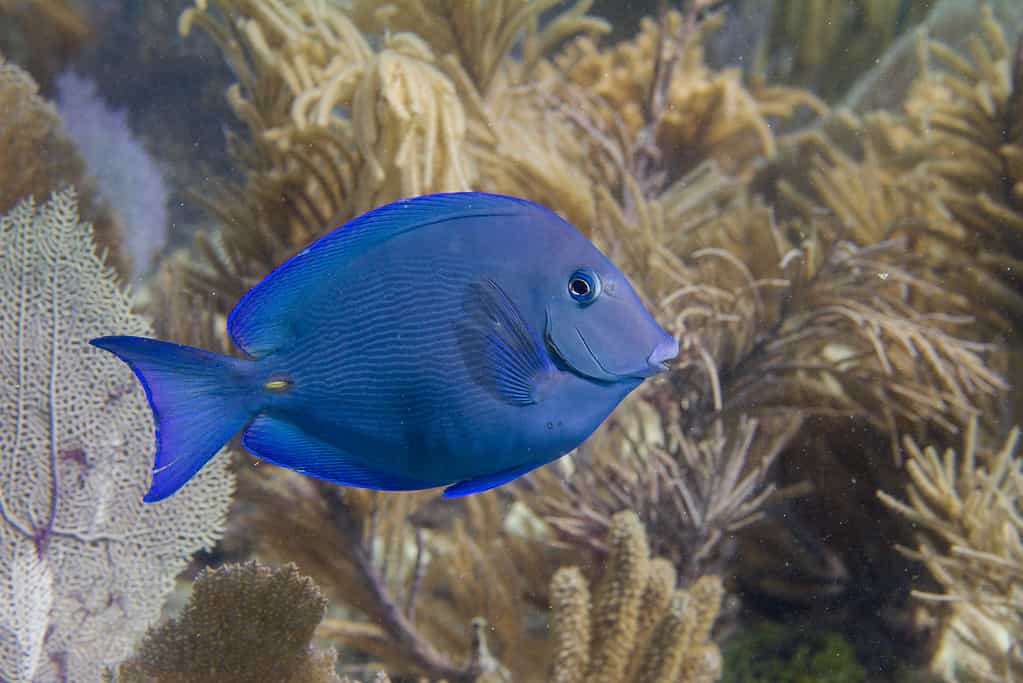
Atlantic blue tang live in many coral reefs in the Florida Keys, including Sombrero Reef.
©iStock.com/pclark2
The wildlife at Sombrero Reef is diverse and abundant, offering a rich marine ecosystem to explore. Snorkelers and divers can witness an array of tropical fish species, including colorful parrotfish, angelfish, sergeant majors, and tangs, swimming among the coral formations. Additionally, encounters with sea turtles, stingrays, and various eels are common. The reef is also a favorite stomping ground for larger pelagic species. For example, there are barracudas, nurse sharks, and the occasional reef shark. The beautiful coral formations and an array of marine inhabitants makes Sombrero Reef a captivating underwater experience.
3. Looe Key Reef

Elkhorn coral (
Acropora palmata) is considered to be one of the most important reef-building corals.
©iStock.com/johnandersonphoto
Looe Key Reef is in the Florida Keys National Marine Sanctuary, south of Big Pine Key. It is renowned as one of the most spectacular coral reefs in the area. It is a popular destination for snorkeling and scuba diving. Looe Key Reef features a wide range of coral formations, including extensive patches of elkhorn and staghorn corals, which provide a vibrant backdrop for underwater exploration. The reef’s location within the marine sanctuary ensures it remains protected. It offers visitors an opportunity to witness the remarkable diversity of marine life in the Florida Keys.
The wildlife at Looe Key Reef is prolific. Snorkelers and divers can encounter an array of colorful tropical fish species. They may find parrotfish, angelfish, butterflyfish, and wrasses, darting among the corals. The reef is also home to various species of rays. Spotted eagle rays and southern stingrays glide gracefully through the crystal-clear waters. Additionally, visitors may come across sea turtles. The lucky viewer may see green and loggerhead turtles, or have an encounter with nurse sharks and reef sharks. With its captivating coral formations and a thriving community of marine species, Looe Key Reef offers an unforgettable underwater expedition.
4. French Reef

Brain coral is a unique feature of French Reef.
©Charlotte Bleijenberg/Shutterstock.com
French Reef is located near Key Largo, Florida, and is part of the John Pennekamp Coral Reef State Park, the first underwater park in the United States. The reef is easily accessible and attracts numerous snorkelers and divers each year. French Reef boasts a diverse array of coral formations, including brain corals, star corals, and finger corals. The reef’s proximity to the shoreline makes it an ideal spot for both beginner and experienced divers to explore its captivating underwater landscape.
The wildlife at French Reef is captivating. Snorkelers and divers can encounter a wide variety of marine species, like colorful tropical fish including parrotfish, wrasses, and sergeant majors. The reef is also frequented by larger inhabitants. Local residents are nurse sharks, barracudas, and the occasional green sea turtle. French Reef’s thriving ecosystem and stunning coral formations make it a must-visit destination for those seeking to immerse themselves in the beauty and biodiversity of Florida’s underwater world.
5. Carysfort Reef
Carysfort Reef is off the coast of Key Largo, Florida, and is one of the most significant coral reefs in the Florida Keys and it is part of the Florida Keys National Marine Sanctuary. Its proximity to the shore makes it easily accessible to divers and snorkelers. Carysfort Reef is characterized by its extensive formations of elkhorn and staghorn corals that provide stunning underwater expanses to explore. The reef has clear waters and vibrant marine life.
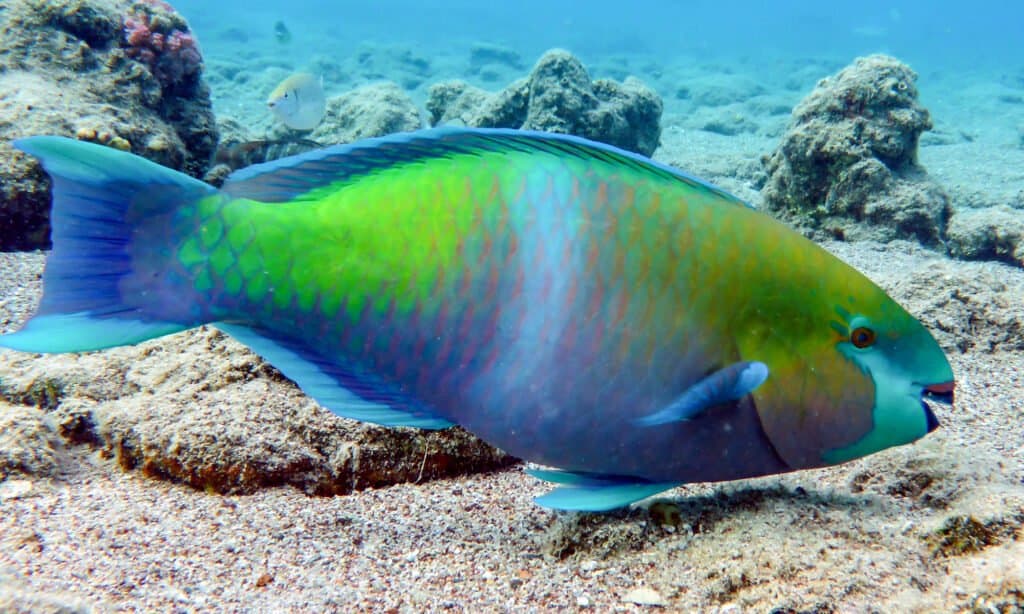
Parrotfish live in coral reefs, such as Carysfort Reef, and seagrass beds.
©FromMyEyes/Shutterstock.com
The wildlife at Carysfort Reef showcases the rich biodiversity of the area. Snorkelers and divers can find a multitude of tropical fish species, including angelfish, butterflyfish, and parrotfish, swimming among the coral formations. The reef is also home to larger marine species, such as nurse sharks, barracudas, and the occasional sighting of majestic sea turtles. Carysfort Reef’s role as a vital habitat for numerous marine organisms makes it a remarkable location to witness the beauty and wonders of Florida’s coral reefs.
6. Alligator Reef
Alligator Reef is located in the Florida Keys, specifically in the Upper Keys region, off the coast of Islamorada. It is a prominent coral reef known for its diverse marine life and beautiful underwater scenery. The reef takes its name from the shipwreck of the USS Alligator, which sank in the area in 1822 and now serves as an artificial reef structure.
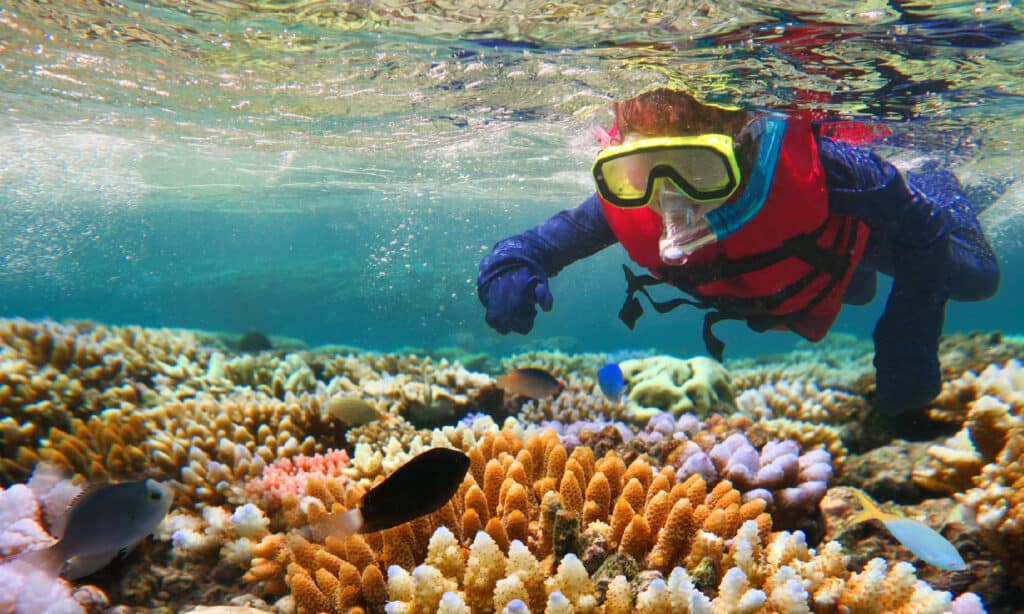
Snorkeling is a fun way to see wildlife in coral reefs.
©iStock.com/chameleonseye
The wildlife at Alligator Reef is highly variable. Snorkelers and divers can explore a thriving ecosystem that includes a wide array of coral formations. Structures include brain corals, elkhorn corals, and sea fans. The reef is home to a range of fish species, including colorful tropical fish like angelfish, parrotfish, and sergeant majors. Additionally, visitors to Alligator Reef may encounter nurse sharks, stingrays, sea turtles, and larger predators like barracudas and reef sharks. With its vibrant marine life and beautiful coral formations, Alligator Reef offers an unforgettable experience for underwater explorers.
7. Conch Reef
Conch Reef is located off the coast of Key Largo, Florida, within the Florida Keys National Marine Sanctuary. It is a prominent coral reef with a diverse marine ecosystem and incredible underwater scenery. The reef is named after the conch shell, which is commonly found in the area.
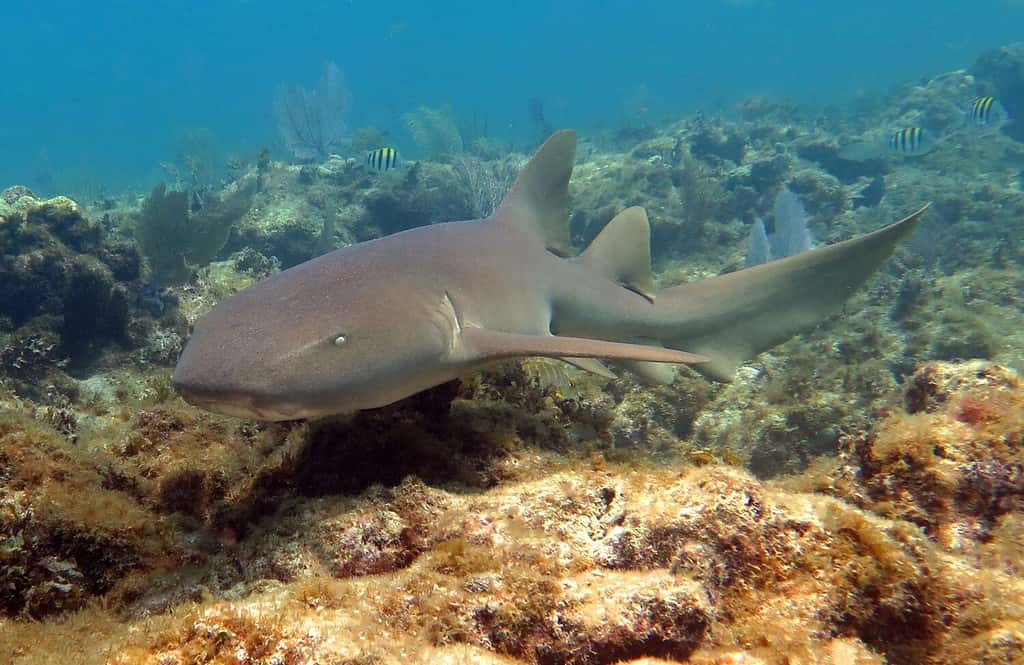
Nurse sharks are a notable species in the Florida Keys.
©Daryl Duda/Shutterstock.com
There is much vibrant wildlife at Conch Reef. Snorkelers and divers can explore a stunning underwater world characterized by extensive coral formations, including elkhorn corals, brain corals, and sponges. The reef is home to a wide variety of fish species, such as parrotfish, angelfish, wrasses, and snappers, which swim among the corals. Visitors may also encounter sea turtles meandering through the water, along with stingrays, nurse sharks, and the occasional sighting of larger pelagic species like barracudas and reef sharks.
8. Pickles Reef
One notable reef in Florida is the Pickles Reef, located off the coast of Key Largo. Pickles Reef is part of the Florida Keys National Marine Sanctuary and supports plentiful marine life and coral formations.

Spotted eagle rays are one of the many beautiful rays in the Florida Keys.
©iStock.com/eaglerayjoel
The reef is in relatively shallow waters, making it accessible to snorkelers and beginner divers. Pickles Reef hosts a range of coral structures, including elkhorn and brain corals, as well as anemones and sponges. The area is teeming with marine species, including colorful tropical fish like parrotfish, butterflyfish, and wrasses. Snorkelers can also spot various types of rays, such as spotted eagle rays and southern stingrays, as well. Additionally, encounters with sea turtles, nurse sharks, and schools of baitfish are common at Pickles Reef. This underwater sanctuary provides a fantastic opportunity to observe and appreciate a diverse marine ecosystem.
9. Dry Rock Reef
Another notable reef in Florida is the Key West Dry Rocks, located approximately seven miles off the coast of Key West. It is part of the Florida Keys National Marine Sanctuary and is easily accessible for snorkelers and divers.

Damselfish are one of the many fish species in Dry Rocks Reef.
©IanRedding/Shutterstock.com
Key West Dry Rocks has magnificent coral formations, such as elkhorn and brain corals, as well as extensive seagrass beds. The reef is home to a diverse range of marine life, making it a haven for underwater biodiversity. Snorkelers and divers can spot colorful fish species including parrotfish, sergeant majors, and damselfish, among others. Sea turtles, including the endangered green sea turtle, also swim in the area. Additionally, the reef attracts larger marine species like nurse sharks, barracudas, and various species of rays. Exploring the Key West Dry Rocks offers a fascinating glimpse into the diverse marine ecosystem found in the waters of Florida.
Summary of 9 Stunningly Beautiful Coral Reefs in Florida
| Coral Reef | Location | |
|---|---|---|
| 1 | Molasses Reef | Florida Keys National Marine Sanctuary |
| 2 | Sombrero Reef | Near Marathon in the Middle Keys |
| 3 | Looe Key Reef | Florida Keys National Marine Sanctuary |
| 4 | French Reef | John Pennekamp Coral Reef State Park |
| 5 | Carysfort Reef | Key Largo |
| 6 | Alligator Reef | Upper Florida Keys |
| 7 | Conch Reef | Florida Keys National Marine Sanctuary |
| 8 | Pickles Reef | Off the Coast of Key Largo |
| 9 | Dry Rock Reef | Key West |
The photo featured at the top of this post is © Willyam Bradberry/Shutterstock.com
Thank you for reading! Have some feedback for us? Contact the AZ Animals editorial team.






